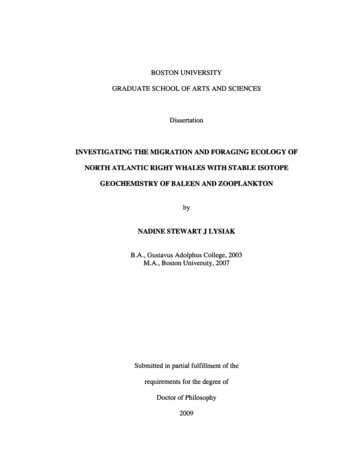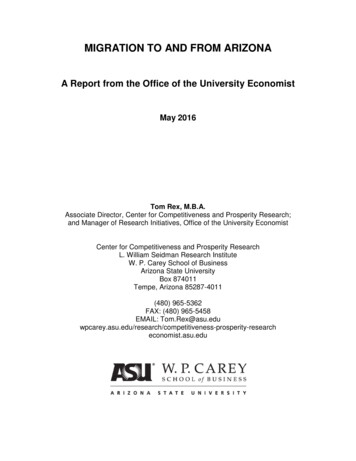
Transcription
BOSTON UNIVERSITYGRADUATE SCHOOL OF ARTS AND SCIENCESDissertationINVESTIGATING THE MIGRATION AND FORAGING ECOLOGY OFNORTH ATLANTIC RIGHT WHALES WITH STABLE ISOTOPEGEOCHEMISTRY OF BALEEN AND ZOOPLANKTONbyNADINE STEWART J LYSIAKB.A., Gustavus Adolphus College, 2003M.A., Boston University, 2007Submitted in partial fulfillment of therequirements for the degree ofDoctor of Philosophy2009
UMI Number: 3334550Copyright 2008 byLysiak, Nadine Stewart J.All rights reserved.INFORMATION TO USERSThe quality of this reproduction is dependent upon the quality of the copysubmitted. Broken or indistinct print, colored or poor quality illustrations andphotographs, print bleed-through, substandard margins, and improperalignment can adversely affect reproduction.In the unlikely event that the author did not send a complete manuscriptand there are missing pages, these will be noted. Also, if unauthorizedcopyright material had to be removed, a note will indicate the deletion. UMIUMI Microform 3334550Copyright 2008 by ProQuest LLC.All rights reserved. This microform edition is protected againstunauthorized copying under Title 17, United States Code.ProQuest LLC789 E. Eisenhower ParkwayPO Box 1346Ann Arbor, Ml 48106-1346
Copyright byNADINE STEWART J LYSIAK2008
Approved ByFirst ReaderValiela, Ph.D.Professor of BiologyBoston UniversitySecond ReaderMichael J. Moore, Ph.D.Adjunct Professor of BiologyBoston University --yThird ReaderMark F. Baumgartner, Ph.D.Assistant ScientistWoods Hole Oceanographic Institution
DEDICATIONJessie Evelyn Willett StewartJune 18,1917 - February 16, 2007This volume is dedicated to my Grammy, Jessie Stewart. She was never able to attendcollege, despite a strong lifelong desire to do so. I am grateful to have had theopportunity to live out one of her dreams through my own pursuit of higher education.The memory of her unfailing optimism and appreciation for all of the beauty in the worldcontinues to be an inspiration to me.iv
ACKNOWLEDGEMENTSI would like to acknowledge the many collaborators with whom I have workedwith over the course of this study; from those who clawed through mountains of decayingright whale flesh to salvage some baleen plates, to the museum curators who let me drillinto their historical treasures, to those who braved the high seas to collect zooplankton forme. Thank you all for your support, efforts, and the samples you brought back with you.The members of the New England Aquarium's Right Whale Research Groupprovided critical advice and data at several stages of this project. They also curate theNorth Atlantic Right Whale Catalog, which is an incredibly time consuming and oftenthankless endeavor. Without that resource, much of this study would not have beenpossible.David Harris and his staff at the University of California Davis Stable IsotopeFacility conducted the stable isotope analysis of my samples with great precision andcare.Fred Wenzel (National Marine Fisheries Service) provided me with a multi-yearzooplankton sampling platform in the Great South Channel, and the chance to observeright whales in the wild. He was a constant supporter of me and my work, and for betteror worse, taught me everything I know about going to sea.My graduate committee provided me with advice, encouragement, andconstructive criticism during my journey to this point. Thank you so much, Drs. AnneGiblin, Vince Dionne, Simon Thorrold, Ivan Valiela, Mark Baumgartner, and MichaelMoore.v
I was lucky enough to be part of two labs: the Valiela Lab at the BostonUniversity Marine Program and the Moore Lab at the Woods Hole OceanographicInstitution. Thank you to all [human and canine] lab members, past and present. Yourcamaraderie and advice has been much appreciated.Dr. Regina Campbell-Malone and Master Andrea Bogomolni (a.k.a. Angel 1 andAngel 2), were both so supportive of me and my ideas. From being sounding boards fortheories large and small, to knowing exactly when we needed to escape to the Landfall thank you both for being such wonderful friends.Thanks to Dr. Carolyn Miller Angell, who early on, gave me some sage adviceregarding the most important words in a dissertation.Dr. Mark Baumgartner has been a wonderful mentor and friend throughout mygraduate career. I would like to thank him wholeheartedly for his numerous intellectualcontributions to my project, enthusiastic participation in all Team Zooplankton activities(which usually took place in sloppy weather), and for all the running commentary fromthe ThunderDome.Dr. Michael Moore (a.k.a. Charlie), eternal dabbler in the Curiosity Business andchallenger of the unknown; you are the best "ideas man" that I know. Thank you somuch for taking this quiet neophyte masters student seriously, for giving me the resourcesto get the job done, and for encouraging me though absolutely every road block along theway. Truly, none of this would have been possible without you, and I wish words existedto convey the depths of my gratitude.vi
To my family (Didee, G-Pup, Aunt Mary, Pequita, Donger, and Thor) and friendswho have become my second family (especially Dr. Jennifer S. H. Culbertson, Julia G.Markoff, Megan English-Braga and Rob Kubitschek, Chris Tremblay, Ingrid Biedron,Alicia Roth, Brian Buczkowski, H. Carter Esch, C.T. Harry, and Dr. Jennifer Bowen):thank you for all the love, laughter, understanding, and perspective you have given meover the last few years. The avalanche cascades.vii
INVESTIGATING THE MIGRATION AND FORAGING ECOLOGY OFNORTH ATLANTIC RIGHT WHALES WITH STABLE ISOTOPEGEOCHEMISTRY OF BALEEN AND ZOOPLANKTON(Order No.)NADINE STEWART J LYSIAKBoston University Graduate School of Arts and Sciences, 2009Major Professor: Ivan Valiela, Professor of BiologyABSTRACTThe foraging grounds of the endangered North Atlantic right whale (Eubalaenaglacialis) are protected under management rulings, but several datasets suggest that rightwhales use habitats far beyond these areas. In 2005, the National Marine FisheriesService published a Right Whale Recovery Plan citing the "characterization andmonitoring of important habitats" as high research priorities.Stable isotopes ratios in animal tissue are intrinsic tags of migration, as they varyregionally in the environment, and are assimilated via trophic transfer. This dissertationdescribes carbon, nitrogen, oxygen, and hydrogen stable isotope ratios in baleen andzooplankton collected in the Gulf of Maine, and their application in determining themigration patterns and foraging ecology of E. glacialis.The Gulf of Maine stable isotope landscape was examined through analysis ofzooplankton samples from seven E. glacialis habitats. Cape Cod Bay, Great SouthChannel, and the Bay of Fundy represent distinct isotope sources to right whales. Allviii
other habitat areas were statistically indistinguishable, and seasonal right whalemovements between these areas cannot be resolved with stable isotope geochemistry.Isotope records in E. glacialis baleen, like those of other large whale species,contain annual oscillations that correspond to broad-scale north/south migrations. Toexamine right whale movement patterns at seasonal time scales, baleen isotope records,the North Atlantic Right Whale Catalog sighting records, and habitat-specificzooplankton stable isotope values were compared. Poor correlations were found betweenobserved and expected baleen isotope values, likely because of the confoundingcontribution of body nutrient pools that were de-coupled from diet (i.e. non-essentialamino acids).Comparisons of recently collected E. glacialis baleen data with isotope recordsfrom late 19 t h - early 20th century baleen revealed a long-term decrease in carbon andincrease in nitrogen isotopes. The observed trends are attributed to increasinganthropogenic inputs of carbon dioxide and nitrogen species, climatic forcing from theNorth Atlantic and Pacific Decadal Oscillations, and poor overall health in the presentday right whale population.The results of this study revealed that right whales use "historic habitat" areasmore frequently than currently assumed, and demonstrates both the spatial/temporallimitations of the stable isotope method and the confounding effect of fluctuatingbiogeochemical signals in the environment.ix
TABLE OF ABLE OF CONTENTSxLIST OF TABLESxiiiLIST OF FIGURESxivLIST OF ABBREVIATIONSxviCHAPTER 1: INTRODUCTION1Figures12CHAPTER 2: VARIABILITY IN THE STABLE ISOTOPE RATIOS OFGULF OF MAINE ZOOPLANKTON AND THEIR UTILITY INSTUDYING BALEEN WHALE MIGRATION14Abstract15Introduction17Materials and edgements39Tables40Figures46x
CHAPTER 3: STABLE ISOTOPE RATIOS OF BALEEN AS INTRINSICMARKERS OF NORTH ATLANTIC RIGHT WHALEMIGRATION55Abstract56Introduction58Materials and edgements85Tables87Figures92CHAPTER 4: EXAMINING LONG-TERM HABITAT USE AND THEINFLUENCE OF ENVIRONMENTAL CHANGE ON STABLE ISOTOPERECORDS IN NORTH ATLANTIC RIGHT WHALEBALEEN108Abstract109IntroductionIllMaterials and Methods112Results and es129xi
Figures133APPENDIX 1: ZOOPLANKTON STABLE ISOTOPE RATIOS149APPENDIX 2: RIGHT WHALE BALEEN STABLE ISOTOPERECORDS158LITERATURE CITED178CURRICULUM VITAE195xii
LIST OF TABLESChapter 2Table 2.1Overview of zooplankton towsTable 2.2Spatial variation in Gulf of Maine zooplankton stable isotope40ratios42Temporal variation of Gulf of Maine zooplankton isotopes43Trophic enrichment of zooplankton: oxygen45Table 3.1Right whale life history data and baleen sampling plan87Table 3.2Elemental abundances and stable isotope ratios in right whaleTable 2.3Table 2.4Chapter 3baleen89Growth rates of adult right whale baleen90Trophic enrichment between right whales and zooplankton, byhabitat91Table 3.3Table 3.4Chapter 4Table 4.1Right whale life history data and baleen sampling plan129Table 4.2Elemental abundances and stable isotope ratios in right whalebaleen130Statistical comparisons of historical and present-day right whalebaleen isotope ratios131Table 4.3xni
LIST OF FIGURESChapter 1Figure 1.1Map of primary right whale habitats and timeline of seasonalhabitat use12Chapter 2Figure 2.1a-bThe Gulf of Maine: study area and tow locations.46Figure 2.2d13C lipid normalization of zooplankton samples48Figure 2.3Spatial trends in Gulf of Maine zooplankton: carbon and nitrogenisotopes49Figure 2.4Spatial trends in Gulf of Maine zooplankton: oxygen an hydrogenisotopes51Contour maps of the Gulf of Maine isotope landscape53Figure 3.1Map of right whale habitat areas in the northwest Atlantic92Figure 3.2Adult right whale baleen stable isotope records94Figure 3.3Immature right whale stable isotope records96Figure 3.4Calf right whale stable isotope records98Figure 3.5Habitat-specific trophic enrichment between zooplankton andright whales: d13C and d15NTrophic enrichment between lactating females and right whale100calves102Figure 3.7Stable isotopes as a tracer of right whale migration104Figure 3.8Demographic separation of stable isotope ratios in right whales106Figure 2.5a-fChapter 3Figure 3.6xiv
Chapter 4Figure 4.1Figure 2.2Nitrogen and carbon stable isotope ratios in right whale baleen,1882-2005133Carbon and nitrogen stable isotope values of historical (18821915) vs. present-day (1986-2005) baleen plates135Figure 4.3Atmospheric carbon dioxide concentrations: 1832-2005137Figure 4.4Nitrogen and carbon stable isotope measurements of right whalebaleen: 1986-2005139Figure 4.5Trends in atmospheric and oceanic carbon dixoide141Figure 4.6Right whale migration patterns143Figure 4.7Right whale reproductive success145Figure 4.8Climatic oscillations: NAO, AMO, PDO, ENSO147xv
LIST OF ABBREVIATIONSAMOAtlantic Multi-decadal OscillationANOVAAnalysis of varianceBoFBay of Fundy CCelsiusCCarbonC5Calanus finmarchicus, fifth stage copepoditeCCBCape Cod BayC. finmarchicusCalanus finmarchicuscmCentimeterCOCarbon monoxideCO2Carbon dioxideCPRContinuous Plankton RecorderCTDConductivity-Temperature-Depth instrumentDDeuteriumDICDissolved inorganic carbonE. glacialisEubalaena glacialisENSOEl Nino Southern OscillationGCGas chromatographGoMGulf of MaineGSCGreat South ChannelGSLGulf of St. LawrenceXVI
HHydrogenH2OWaterIRMSIsotope ratio mass spectrometerJLJeffrey's LedgekmKilometersLSWLabrador Slope llimeterMOCNESSMultiple Opening and Closing Net Environmental Sensing SystemnSample sizeNNitrogenN2Atmospheric nitrogenNAONorth Atlantic OscillationNEGBNortheast peak of Georges BankOOxygenPDBPeeDee BelemnitePDOPacific Decadal OscillationRBRoseway BasinSDStandard deviationxvii
SEStandard errorSEUSSoutheast United StatesSLWSlope waterSSTSea surface temperatureSSWScotian Shelf WaterVSMOWVienna Standard Mean Ocean WaterWSWWarm Slope WateryrYearxvm
1CHAPTER 1INTRODUCTION
2MotivationDespite protection from targeted commercial whaling, North Atlantic right whales(Eubalaena glacialis) remain one of the world's most endangered species (IWC 2001a).Studies of North Atlantic right whale demography have shown that, given its smallpopulation size, even single mortality events are significant. Therefore preventing thedeaths of two females per year could considerably reduce the species' mortality rate andextinction probability (Fujiwara and Caswell 2001). In light of this analysis, a string ofright whale mortalities that occurred between February 2004 and May 2005 greatlyalarmed researchers (see Kraus et al. 2005). In that sixteen month period, eight whaleswere found dead, three of which were carrying full term fetuses (Right WhaleConsortium 2008a). Five of these cases could be attributed to human activities, asdiagnostic necropsies demonstrated that the whales were killed by vessel strike or fishinggear entanglements (Moore et al. 2006, Campbell-Malone et al. 2008).Vessel strikes and entanglement in fishing gear are the primary forms of largewhale anthropogenic mortality (Knowlton and Kraus 2001, Moore et al. 2005, Nelson etal. 2007), and these sources account for 64% of documented right whale mortalities1(Right Whale Consortium 2008a). Additionally, 75.6% of right whales bear scarsindicative of interactions with fishing gear (Knowlton et al. 2005), suggesting that fewright whales have escaped an encounter with gear and that entanglements are likelyunder-reported. In addition to the conservation risk they pose, these forms ofanthropogenic mortality are also issues of animal welfare. For example, observations of1Statistic calculatedfrompost-mortem examinations of 42rightwhale carcasses betweenl970 and 2007(Right Whale Consortium 2008a).
3free-ranging whales and post-mortem examinations of carcasses have demonstrated thatwhales can die slowlyfromboth classes of mortality, especially gear entanglements(Moore et al. 2005, Moore et al. 2006, Campbell-Malone et al. 2008).Researchers and managers agree that reducing anthropogenic mortalities is of thehighest priority for right whale recovery plans (Kraus et al. 2005, NMFS 2005). Yet, theimplementation of effective conservation measures has been slow given the socioeconomic impact of regulating the activities of fishing and shipping industries. In orderto draft effective management plans mat can reconcile the interests of these industrieswith the ultimate goals of whale conservation, accurate and detailed informationregarding where and when right whales occur is needed.With respect to our understanding of right whale ecology, significant knowledgegaps in the areas of migratory connectivity and habitat use exist despite directed researcheffort since the 1980s. Given the population's small size and high anthropogenicmortality rate, this is concerning. Since conservation and management initiatives areonly as sound as the science upon which they are based, these knowledge gaps are asignificant hindrance to successful right whale conservation efforts. In an attempt toclose this knowledge gap, a multi-year study was conducted to describe the stable isotopegeochemistry of baleen in order to infer patterns of right whale migration. By way ofgeneral introduction to this study, the following chapter outlines important informationabout North Atlantic right whales and stable isotope geochemistry as a method forstudying animal migration.
4Right Whales: Worldwide Status and TaxonomyRight whales (genus Eubalaena) are a group of mysticete cetaceans characterizedby a robust body, broad paddle-like flippers, a narrow and arched upper jaw with adeeply curved jawline, long ( 2 m) baleen plates, and a large head relative to their bodysize (which comprises 30% of their total length) (Kenney 2002). Three right whalespecies are currently recognized: Eubalaena australis (Southern right whales), Eubalaenajaponica (North Pacific right whales), and Eubalaena glacialis (North Atlantic rightwhales) (Rosenbaum et al. 2000). All three species were targeted in various commercialwhaling efforts, and were prized for their high yield of oil and baleen, coastaldistribution, and fairly slow swimming speeds. Each species was heavily exploited, suchthat all were significantly depleted by the beginning of the twentieth century (Tormosovet al. 1998, Clapham et al. 2004, Reeves et al. 2007).The recovery success of right whales since targeted whaling activities ceased hasbeen species dependent. The different degrees of recovery likely stem from: the variedintensity and timing of exploitation, the degree of industrialization in each species'primary habitat areas, each population's pre- and post-exploitation genetic diversity, theoccurrence and severity of disease within each population, and regional differences infood availability (IWC 2001a). Southern right whales have demonstrated the strongestrecovery; and the extant population is estimated at 7,500 individuals with a 7-8 % annualgrowth rate (IWC 2001b). By contrast, North Pacific right whales are so rare (with apopulation estimate in the dozens to low hundreds) that individual sightings are worthy ofpublication (e.g. Rowntree et al. 1980, Tynan et al. 2001). Although North Atlantic right
5whales were once prolific on both sides of the Atlantic, today right whales in the easternAtlantic are scarce (Brown 1986). A small relict population, estimated at 400 individuals(Right Whale Consortium 2007), is found in the western North Atlantic. Given theseapproximations of population size, North Pacific and North Atlantic right whales areconsidered the most endangered species of large whales in the world due to their apparentlack of recovery despite several decades of international protection from commercialharvest (Clapham et al. 1999).North Atlantic Right Whales2Population BiologyIn addition to a high anthropogenic mortality rate, a reduced reproductive rate is amajor factor hindering right whale recovery (Kraus et al. 2005). Right whalereproductive and population biology are characterized by a low overall reproductive rate,high degree of variability in annual calf production and inter-annual calving intervals,and a significant number of nulliparous adult females (Kraus et al. 2007). Althoughstereotypical right whale calving events occur on three year cycles (including one year ofgestation (Best 1994), approximately one year of lactation (Hamilton et al. 1995), and ayear of rest before a subsequent pregnancy) female right whales have experienced longercalving intervals on average. The mean calving interval for the population has also beenvariable It is hypothesized that limitations in food availability, disease, and theconsequences of low genetic variability are potential factors contributing to the poor2Given the focus of this dissertation, the term "right whale" will herein refer to the northwest Atlanticstock of Eubalaena glacialis
6reproductive success of the right whale population (Greene and Pershing 2004, Frasier etal. 2007, Kraus et al. 2007).Foraging EcologyRight whales are zooplankton specialists, and feed primarily on the calanoidcopepod Calanusfinmarchicus(Murison and Gaskin 1989, Mayo and Marx 1990,Beardsley et al. 1996, Baumgartner and Mate 2003). C.finmarchicusis the dominantcopepod species of the boreal North Atlantic, and is characterized by a life history cyclethat includes a resting stage known as diapause. In preparation for diapause, late stagecopepodites sequester lipids in a membrane-bound organelle (oil sac). The oil sac growsas lipids accumulate, and can eventually fill over half of the volume of the body (Milleret al. 1998), making C.finmarchicusand energy rich prey item. During diapause, fifthstage copepodites (C5) migrate to depth and enter a state of arrested development whichallows them survive periods of low food availability (Hirche 1996).In contrast to other mysticete cetaceans, right whales exhibit no behaviors thatserve to corral their food; instead they rely completely on the environment (or thezooplankton themselves) to concentrate their prey into dense, exploitable patches(Baumgartner et al. 2007). Right whale feeding behavior is quite basic; an individualsimply opens its mouth and swims forward. The hundreds of baleen plates in a whale'smouth filter zooplankton from the water column in a very efficient manner (Werth 2007).Right whales have been observed feeding in this manner at the surface (known as skimfeeding, Mayo and Marx 1990) or at various depths below the surface. Using suction-cup
7mounted time-depth-recorder tags, Baumgartner and Mate (2003) demonstrated thatduring sub-surface feeding bout, right whales foraged on thin dense layers of C5s, whichwere often concentrated at the bottom mixed layer. In both surface and sub-surfacefeeding scenarios, right whales seem highly attuned to the density of plankton in theirfeeding path and modify their depth or trajectory in order to exploit the densest patches ofplankton.Distribution and MigrationFor a significant portion of each year, North Atlantic right whales are found in thecoastal waters of the eastern United States and Canada. Four primary feeding habitats areused seasonally by a large proportion of the right whale population (Fig. 1.1). Theseinclude: Cape Cod Bay (CCB, from January - April), the Great South Channel (GSC,from April - July), the lower Bay of Fundy (BoF, from July - October), and RosewayBasin (RB, from July - October) (Kraus et al. 1986a, Winn et al. 1986, Murison andGaskin 1989, Hamilton and Mayo 2001 Hamilton et al. 2007). Right whales are alsofound, in fewer numbers, in: Chaleur Bay/Gulf of St. Lawrence (GSL, in the summer andfall, Y. Guilbault, pers. comm.); Jeffrey's Ledge (JL, from October - November,Weinrich et al. 2000); the northeastern flank of Georges Bank (NEGB, in the summermonths, Niemeyer et al. 2008); and the central GoM (winter months, Cole et al. 2007).The only known calving ground is located in the southeast US (SEUS), in the coastalwaters off Georgia and Florida, and is occupied from November - February (Kraus et al.1986a, Hamilton et al. 2007).
8Analyses of multiple datasets (including survey, photo-ID/mark-recapture, andgenetic) suggest thatrightwhales may use areas which are ancillary to their recognizedhabitats. Five right whale habitats (Cape Cod Bay, Great South Channel, Bay of Fundy,Roseway Basin, and southeast US) are protected, to various degrees, by managementrulings such as vessel speed restrictions, re-routed shipping lanes, or fishing gearmodifications. The characterization and monitoring of additional habitats has been citedas a research priority by managers (NMFS 2005). Given the high level of anthropogenicmortality that is already observed in the North Atlantic right whale population, a betterunderstanding ofrightwhale distribution, and the threats they face therein, is urgentlyneeded to improve their conservation and recovery potential.Stable Isotope GeochemistryStable isotope analysis has become an established method for examining the flowof nutrients through ecosystems (Peterson and Fry 1987), and many studies utilize it toreconstruct trophic relationships (Kelly 2000). Organisms acquire stable isotopesignatures from their diet and the isotopic value of animal tissues are predictably enrichedcompared to those of their food source (DeNiro and Epstein 1978,1981). Additionally,stable isotope values in the environment, which are controlled by a variety of abioticfactors, are incorporated into food webs by producers (Rubenstein and Hobson 2004).Therefore, stable isotope data can provide a metric of what and where an animal hasrecently eaten.
9The tissue that is chosen for stable isotope analysis determines what kinds ofecological questions a study can answer. Since the degree of a tissue's metabolic activitydictates its isotopic turnover rate, tissues like blood and liver having fast turnovers (onthe order of days to weeks) representing short feeding histories, and tissues like skin andmuscle having slower turnovers (weeks to months) and integrating longer feedinghistories. In contrast, the stable isotope values of metabolically inactive tissues, such askeratin structures, do not change after they are formed (Hobson 2005). New growth istagged by the most recently acquired food source. Accreting keratin structures, such ashair, baleen, claws, and feathers, can therefore become temporal records of stable isotoperatios if they are sampled incrementally (Bowen et al. 2005b).Baleen, composed of keratin, is an ideal tissue for stable isotope analysis. It ismetabolically inactive, and is formed from blood metabolites (amino acids) and thus newgrowth responds relatively quickly to dietary changes (Ayliffe et al. 2004). It accretescontinuously over each year (Lubetkin et al. 2008) yet also wears away at the tip suchthat the longest plates in some species contain over ten years of isotope data, thusproviding a decadal-scale record of migration behavior.Large whales are well suited for isotope studies because they consume largeamounts of prey over extensive areas, thereby incorporating the seasonal and geographicvariations of stable isotopic ratios of their prey into their own tissues as they move fromone region to another. Previous studies have applied stable isotope analysis to the baleenof gray (Caraveo-Patino and Soto 2005, Caraveo-Patino et al. 2007), minke (Mitani et al.2006), bowhead (Schell et al. 1989, Schell and Saupe 1993), and Southern right whales
10(Best and Schell 1996); and have demonstrated the utility of this approach for describingannual movement patterns. In all mysticete species studied to date, annual oscillations inthe carbon and nitrogen stable isotope ratios of baleen have been observed. Theseoscillations can be differentiated into seasonal nutritional sources, corresponding toobserved annual migrations by each whale species between high and low latitudehabitats. Stable isotope measurements have been useful in determining residence time orthe relative amount of nutrition each whale species derives from its respective seasonalhabitats (Lee et al. 2005).Two preliminary studies measured stable isotope ratios in baleen collected from atotal of six individual North Atlantic right whales (Wetmore 2001, Summers et al. 2006).Both studies observed annual oscillations in baleen carbon and nitrogen stable isotoperatios, but were unable to resolve right whale migration behavior at small spatial or shorttemporal scales. Akin to previous studies with the baleen from other species, theseanalyses were only been able to differentiate movement of individuals between winterand summer habitats. In die following study, additional stable isotope ratios will bemeasured in baleen collected from a greater number and diversity of individuals, andmigration behavior will be examined at finer scales.Dissertation OverviewThis dissertation examines stable isotope ratios in baleen and zooplankton, as theyrelate to North Atlantic right whale migration and habitat use. It is composed of four
11sections: (1) Characterization of the spatial and temporal variability in the C, N, O, and Hstable isotope values of zooplankton collected in the Gulf of Maine; (2) Examination ofthe trends and patterns of stable isotope ratios in right whale baleen plates; (3)Comparison of baleen stable isotope signatures with right whale biological data such asage, reproductive events, and sighting records; (4) Comparison of baleen stable isotopesignatures collected from present-day and historical specimens.
12Figure 1.1: Map of Primary Right Whale Habitats and Timeline of Seasonal HabitatUse. Four habitats in the Gulf of Maine (Cape Cod Bay, Great South Channel, Bay ofFundy, and Roseway Basin) and the only known calving ground (southeast US) aredemarcated by polygons. Two other important habitat areas, Jeffreys Ledge ChaleurBay, and the northeast peak of Georges Bank, are shown with arrows. The timelinebelow the map outlines the seasonal occupation of these habitats by right whales. CapeCod Bay (CCB) is used from January - April, Great South Channel (GSC) is used fromApril - July, the Bay of Fundy/Roseway Basin/NE Georges Bank are used from July October, Jeffreys Ledge (JL) is used from October - November, and the southeast US(SEUS) is used from November - February.
13Figure 1.1: Map of primary right whale habitats and timeline of seasonal habitat AMJJASON
14CHAPTER 2VARIABILITY IN THE STABLE ISOTOPE RATIOS OF GULF OF MAINEZOOPLANKTON AND THEIR UTILITY IN STUDYING BALEEN WHALEMIGRATION
15ABSTRACTStable isotope analysis of animal tissues can be used as an intrinsic marker ofmigration, but this method relies on the unambiguous identification of the isotopiclandscape over which an animal roams and derives nutrition. Several basin-scale carbon,nitrogen, oxygen, and hydrogen stable isotope landscapes have been described for thegreater North Atlantic
boston university graduate school of arts and sciences dissertation investigating the migration and foraging ecology of north atlantic right whales with stable isotope geochemistry of baleen and zooplankton by nadine stewart j lysiak b.a., gustavus adolphus college, 2003 m.a., boston university, 2007 submitted in partial fulfillment of the










